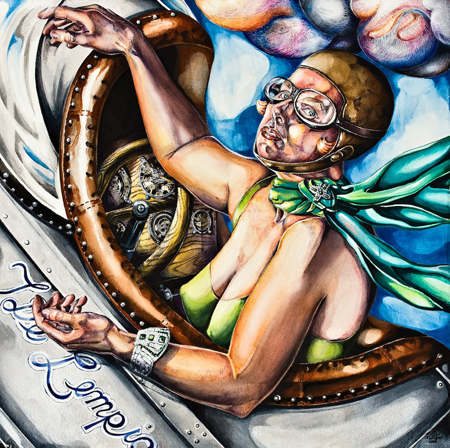Brigham’s earliest work based on flight is Zephyr, Angel, Wings and Me, completed in 2002. The work displays the artist as Amelia Earhart with butterfly wings and holding on to a baby. Zephyr, the Greek god of wind, signifies the baby who is Brigham’s son, Noble. He is portrayed with a human head and the body of a pupa signifying transformation and ones ability to transcend beyond traditional roles. Amelia Earhart is the Angel because of her plane being lost. Wings is representative of the elements of flight such as the butterfly wings, the airplane and the pupa’s future. She subtly incorporates flight by positioning her hands to resemble the blades of a propeller. Two collaged photographs of Earhart in the background of the work reference a recurring dream that Brigham has of Amelia Earhart landing safely on her final flight. Zephyr, Angel, Wings and Me combines Brigham’s themes of flight, birth, motherhood and transformation, while honoring the achievements of Amelia Earhart.
WASP Bea. I. Wolf. Holly Trostle Brigham. 2012.
In February 2012,
Brigham participated in a group exhibition of ten artists, Home Front Heroes: Women of World War II, at Penn State University
at Lehigh Valley. In the
early 1940s, during World War II, thousands of women enrolled in courses and
sought employment in drafting, chemistry, management, defense training and
other skills offered by Penn State Lehigh Valley, filling roles left vacant by
men fighting overseas. Brigham contributed her work, WASP Bea. I. Wolf, to the exhibition, which depicts a woman who
served in the Women Airforce Service Pilots in the Army Air Corps (WASP). Her
work recognizes the many women who bravely served going beyond their
established roles in society.
Tamara de Lempicka: On Autopilot. Holly Trostle Brigham. 2009.
 The work, Tamara
de Lempicka: On Autopilot, does not depict a woman aviator, but artist, Tamara de Lempicka, who painted celebrities in Europe
during the 1920s and 1930s and was well known for her collections of fancy cars
and jewelry. De Lempicka is flying on autopilot, so Brigham could
spotlight the spectacular pieces of jewelry that de Lempicka actually
owned! Brigham speculates that de Lempicka
could have had the opportunity to fly because she was a wealthy woman who was
sporty and adventurous. Even if de Lempicka had not ever flown, she sailed
beyond what was expected of a woman during her time.
The work, Tamara
de Lempicka: On Autopilot, does not depict a woman aviator, but artist, Tamara de Lempicka, who painted celebrities in Europe
during the 1920s and 1930s and was well known for her collections of fancy cars
and jewelry. De Lempicka is flying on autopilot, so Brigham could
spotlight the spectacular pieces of jewelry that de Lempicka actually
owned! Brigham speculates that de Lempicka
could have had the opportunity to fly because she was a wealthy woman who was
sporty and adventurous. Even if de Lempicka had not ever flown, she sailed
beyond what was expected of a woman during her time.
Flight, to Brigham, is more than piloting a
plane or soaring through the clouds wearing a cape. She interprets flight as a
metaphor for women aspiring to go beyond stereotypical women’s roles. All of
the women Brigham has chosen to depict were determined to succeed in
environments that were, for the most part, unreceptive to women. Brigham reminds
viewers of the challenges these super women faced and keeps their bravery alive
through her works.
Holly Trostle Brigham: Dis/Guise will be on view at the Luther W. Brady Art Gallery until February 28, 2014.
Taylor Schmidt, Gallery Assistant



No comments:
Post a Comment